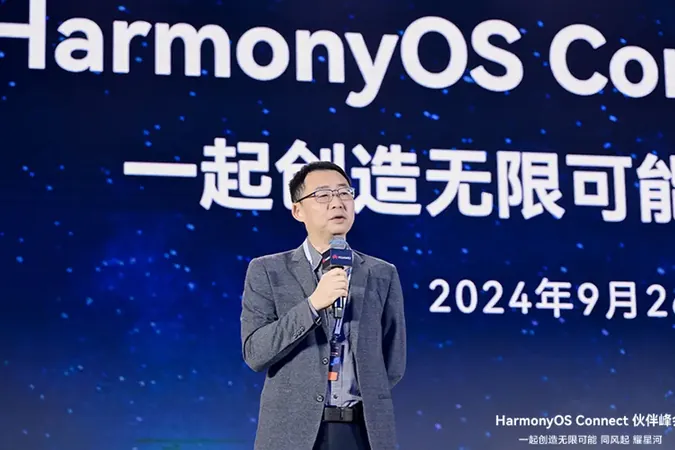
Huawei Launches HarmonyOS for PCs: A Bold Move to Challenge Tech Giants
2025-05-26
Author: Daniel
Huawei Takes on Windows and Mac: A Game-Changer in OS Development
In a daring attempt to break the stranglehold of Windows and Mac OS, Huawei has officially launched its PC version of HarmonyOS, marking a significant milestone in the tech giant's ongoing battle to compete in the global operating system market. This ambitious launch comes as Huawei expands its ecosystem, aiming to attract more app developers to its platform.
The Road Less Traveled: A Necessity for Huawei
With the U.S. banning Huawei from using Android, the company found itself at a crossroads. Developing an operating system is no small feat—especially convincing developers and users to embrace an entirely new platform. Huawei's HarmonyOS was born out of necessity, aiming to establish a credible alternative in a landscape dominated by two heavyweights:
The Showdown: Huawei's Latest Offerings
Recently unveiled, Huawei introduced two impressive laptops powered by HarmonyOS 5.0: the MateBook Fold and the MateBook Pro. The MateBook Fold features an extraordinary 18-inch OLED dual screen and is priced at 23,999 yuan ($3,331), while the MateBook Pro offers a more traditional design starting at 7,999 yuan.
Building Towards Self-Sufficiency: Huawei’s Strategy
Huawei's journey towards OS independence has been fraught with challenges. Following U.S. sanctions, the company has focused on creating a self-sufficient supply chain, developing advanced semiconductors, and, of course, its own operating system. At the launch, Huawei emphasized its commitment to "doing the hard but right things," tapping into national pride with its messaging.
The App Ecosystem: Progress and Pitfalls
More than 1,000 applications have already adapted to HarmonyOS, including key players like WPS and the work collaboration app Feishu. However, it still faces hurdles; HarmonyOS needs a broader range of fully functioning apps to truly compete with Android and iOS.
A Beacon of Hope: WeChat's Launch on HarmonyOS
A pivotal moment came with the introduction of a WeChat version on HarmonyOS, following extensive testing. WeChat is ubiquitous in China, used for everything from messaging to payments. Alongside WeChat, several major apps like Douyin (Chinese TikTok) are now available, signaling progress.
Challenges Ahead: The Developer Dilemma
Despite the promising developments, Huawei faces significant challenges. Convincing developers to invest in HarmonyOS is critical; if the app experience doesn’t match user expectations, they risk losing their audience. The vicious cycle of poorly supported applications could hinder Huawei's ambitious goals.
User Backlash: Navigating Early Adoption
Huawei's push for users to migrate to HarmonyOS 5.0 faced backlash when the company removed the option to revert to prior versions, leading some users to encounter compatibility issues. This misstep highlights the need for Huawei to balance its aggressive strategies with user experience.
The Future: A Strategic Gamble for Huawei
With Huawei boasting 282 million active smartphones in China, the user base could provide a solid foundation for HarmonyOS. However, careful navigation is essential; the company must allow developers to enhance app functionalities while gradually boosting user adoption.
Huawei's Vision: The Internet of Things (IoT)
Ultimately, Huawei’s efforts with HarmonyOS are not just about profit but about survival in a fast-evolving tech landscape. Its ambition to cater to the future of the Internet of Things (IoT), connecting not just smartphones but a myriad of devices, further solidifies its place in an incredibly competitive market. HarmonyOS is more than an OS; it’s a strategic lifeline and could pave the way for a tech revolution in China.



 Brasil (PT)
Brasil (PT)
 Canada (EN)
Canada (EN)
 Chile (ES)
Chile (ES)
 Česko (CS)
Česko (CS)
 대한민국 (KO)
대한민국 (KO)
 España (ES)
España (ES)
 France (FR)
France (FR)
 Hong Kong (EN)
Hong Kong (EN)
 Italia (IT)
Italia (IT)
 日本 (JA)
日本 (JA)
 Magyarország (HU)
Magyarország (HU)
 Norge (NO)
Norge (NO)
 Polska (PL)
Polska (PL)
 Schweiz (DE)
Schweiz (DE)
 Singapore (EN)
Singapore (EN)
 Sverige (SV)
Sverige (SV)
 Suomi (FI)
Suomi (FI)
 Türkiye (TR)
Türkiye (TR)
 الإمارات العربية المتحدة (AR)
الإمارات العربية المتحدة (AR)